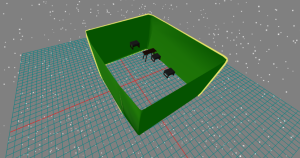Risks:
The biggest risk lies in fine tuning our design in time for the final demo. The main way to fix this is to meet up over the course of the week and test all the parts of the system very rigorously.
Another issue is that a more powerful motor that we ordered has not arrived yet. Our system still works end to end, so in the worst case scenario it does not arrive, we will continue to use our current motors and accommodate accordingly.
Design Changes:
We haven’t made any major changes to the design.
Schedule Changes and Updates:
No major schedule updates.
Tests and Analysis:
Unit Tests Conducted:
Room Dimension Accuracy:
- Procedure: We scanned the room and compared the model’s width and depth with actual measurements obtained using a tape measure.
- Findings: The current model had a measurement error of approximately 150 mm, which exceeds our goal of less than 80 mm error.
Z-Axis Accuracy:
- Procedure: We measured the distance from the sensor to the floor and compared it with the height reading provided by the sensor.
- Findings: The Z-axis positioning accuracy was within 22 mm error, which is under our performance goal of less than 30 mm error.
Web App Performance:
- Procedure: We measured the response time from scan completion to the model display in the web application.
- Findings: The average response time was around 10 seconds per 6 square meters, well under the maximum allowable time of one minute.
System Test:
- Procedure: We conducted a full system integration test to evaluate how well the different components of the system work together in real-time. This test was crucial to ensure that the data flow from the LiDAR scan, through processing and up to display in the web application, was seamless and efficient.
- Findings: The system performed well during the integration test. However, during the scanning phase that involved using a stepper motor to elevate the scanning platform, we observed that the platform’s upward movement was considerably slower than expected. This slow movement could impact the overall system efficiency. There was also an unintended slight tilt forward that was occurring due to an imbalance in the weight. To accommodate this, we attached another small counterweight to the back end of the stand to level out the platform.
Findings and Design Changes:
- Room Dimension Accuracy: We are trying to improve the dimensional accuracy by adjusting parameters for generating the model. We are also trying to achieve this by varying the z-axis start and end position of the scan, as we have found that with our new tilt mechanism, the start position of the scan can cause unintended readings from the floor.
- Platform Speed Adjustment: To address the slow movement of the stepper motor-driven platform, we are testing with different models of stepper motors.
Developments:
We’re in the endgame now. We’ll be finetuning everything until demo comes.

